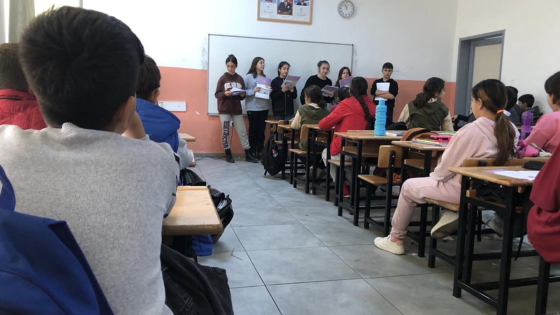In her presidential address to the Population Association of America, Sara McLanahan documents a striking increase in inequality in children's home environments over the last five decades across families where mothers have different levels of education.1 The trends documented in these and other papers are cause for great concern because the home environment is probably the best candidate for explaining inequality in child development.2 How can economic policy respond to this?
The approach put forward by McLanahan relies on changes to the welfare system. The effectiveness of such proposals is still to be assessed. However, given that home environments are rooted in the experiences of each family, they are probably difficult to change if we rely only on the welfare system, while more direct interventions require invading family autonomy and privacy, and thus are notoriously difficult to enforce.
A possible alternative is to target future parents in their youth, by affecting their education, before they start forming a family. We assess the potential for such a policy, by estimating the impact of maternal education on home environments and on child outcomes.
Results from recent research based on the NLSY79
The National Longitudinal Survey of Youth 1979 (NLSY79) is well-suited for such an investigation. This US survey contains detailed longitudinal information about the lives of a sample of Americans aged between 15 and 22 years old in the first survey round of 1979. Since 1986, this survey also follows the children of the female members of the NLSY79, regularly collecting data on a large set of children's characteristics at different ages.
The methodological challenge is to disentangle the causal effect of education from selection effects. In this work, we exploit differences in the schooling costs across counties where the sample mothers grew up and the way these change over time, to estimate the causal impact of mothers’ schooling on the outcomes of their children. As schooling cost measures, we use both opportunity costs of schooling (local wages and local unemployment rates) as well as direct costs of schooling (local college tuition and local college availability). We allow for permanent differences between regions and cohorts, so that our results can be interpreted as exploiting differential changes in the schooling cost variables across counties.
We study a wide-ranging set of child outcomes, including performance on standardised test scores and behavioural problems at different ages.
Table 1 shows the estimated effect of an additional year of maternal education on a number of outcomes for white children. Column (1) reports the results for children aged 7-8, column (2) for children aged 12-14.
Table 1: Effect of maternal education on child outcomes (white children)
|
|
Child age
|
|
|
7-8 yrs
|
12-14yrs |
|
|
(1)
|
(2)
|
|
PIAT math test
|
0.097
|
0.024
|
|
(standardized score)
|
[0.031]***
|
[0.033]
|
|
PIAT reading test
|
0.075
|
0.018
|
|
(standardized score)
|
[0.033]**
|
[0.033]
|
|
Behavioural Problem Index
|
-0.092
|
-0.116
|
|
(standardized score)
|
[0.043]**
|
[0.041]***
|
|
Grade repetition
|
-0.028
|
-0.028
|
|
(indicator)
|
[0.008]***
|
[0.011]**
|
|
Overweight
|
-0.015
|
-0.012
|
|
(indicator)
|
[0.013]
|
[0.013]
|
Source: Table 6 from Carneiro, Meghir, and Parey (2007, CEPR DP6505). Table shows effect of maternal education and corresponding standard error. Stars indicate level of significance.
For white children, our results show that maternal education increases the child's performance in both mathematics and reading at ages 7-8, but these effects are not seen at ages 12-14. To give a sense of the magnitudes, the results indicate that an additional year of maternal education improves performance on a maths test by 0.1 of a standard deviation at ages 7-8. Maternal education also reduces the incidence of behavioural problems and reduces grade repetition, but we find no effect on obesity. For black children, the results follow a similar pattern, but we do not see a decline of the effect at ages 12-14 in the test score results, and effects on grade repetition are stronger.
An important follow-on question is to try to shed light on the channels by which the effect of parental education is transmitted to the child, in particular to understand how maternal education alters the home environment of the child. Thus, in the second step, we investigate how parental education affects the home environment, with a particular focus on parental investments in their children.
Table 2: Effect of maternal education on family environment variables (white children)
|
Maternal age
|
1.024
|
|
(in years, at birth of child)
|
[0.139]***
|
|
Number of children
|
-0.017
|
|
|
[0.057]
|
|
Marital status
|
0.041
|
|
(indicator)
|
[0.018]**
|
|
Spouse schooling
|
0.549
|
|
(in years)
|
[0.092]***
|
|
Hours worked
|
55.633
|
|
(annual hours)
|
[38.528]
|
|
Log family income
|
0.177
|
|
|
[0.034]***
|
|
Maternal aspirations
|
0.048
|
|
(indicator)
|
[0.018]***
|
Source: Table 9 from Carneiro, Meghir, and Parey (2007, CEPR DP6505). Table shows effect of maternal education and corresponding standard error. Stars indicate level of significance.
Our results suggest that more educated mothers delay child-bearing and have substantially better educated spouses and higher family income. For example, an additional year of maternal schooling increases total family income (which includes the spouse’s income) by almost 18 %. Educated mothers are also found to be more likely to invest in their children through books, providing musical instruments, special lessons, or availability of a computer. Even though they work more, more educated mothers do not spend less time breastfeeding, reading to their children or taking them on outings.
In summary, our results indicate that the intergenerational return to education is substantial. The large effect of maternal education on child outcomes is consistent with the notion that children benefit from additional parental education through a variety of channels, including parental investments.
Policy implications
Intergenerational transmission is important for understanding long-term policy effectiveness. This is relevant because many programmes are struggling to improve outcomes for poor children. Programmes which manage to increase mother's schooling are likely to be important not only for mothers now but also for their future children, and should be designed and judged with this in mind.
References
Cameron, S. V. & Heckman, J. J. (2001), 'The Dynamics of Educational Attainment for Black, Hispanic, and White Males', Journal of Political Economy 109(3), 455-499.
Carneiro, P.; Heckman, J. J. & Masterov, D. V. (2005), 'Labor Market Discrimination and Racial Differences in Premarket Factors', Journal of Law and Economics 48(1).
Carneiro, P.; Meghir, C. & Parey, M. (2007), 'Maternal Education, Home Environments and the Development of Children and Adolescents', CEPR Discussion Paper DP6505. Link: www.cepr.org/pubs/dps/DP6505.asp
Fryer, R. G. J. & Levitt, S. D. (2007),'Testing for Racial Differences in the Mental Ability of Young Children', Manuscript, Harvard University.
Fryer, R. G. J. & Levitt, S. D. (2006), 'The Black-White Test Score Gap Through Third Grade', American Law and Economics Review 8(2), 249-281.
Fryer, R. G. J. & Levitt, S. D. (2004), 'Understanding the Black-White Test Score Gap in the First Two Years of School', The Review of Economics and Statistics 86(2), 447–464.
Jencks, C. & Phillips, M. (1998), The Black-White Test Score Gap, Brookings Institution Press.
McLanahan, S. (2004), 'Diverging Destinies: How Children Are Faring Under the Second Demographic Transition', Demography 41(4), 607-627. Link: http://muse.jhu.edu/journals/demography/v041/41.4mclanahan.pdf
Todd, P. E. & Wolpin, K. I. (2006),'The Production of Cognitive Achievement in Children: Home, School and Racial Test Score Gaps', Manuscript, University of Pennsylvania.
Footnotes
1 See McLanahan (2004).
2 See Jencks and Phillips (1998), Cameron and Heckman (2001), Fryer and Levitt (2004, 2006, 2007), Carneiro, Heckman, and Masterov (2005), Todd and Wolpin (2006).





